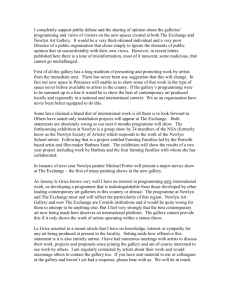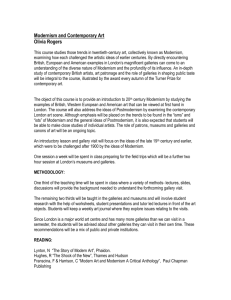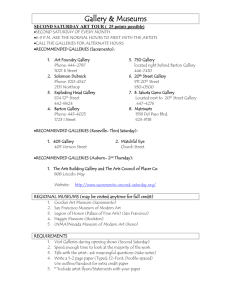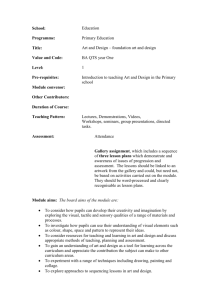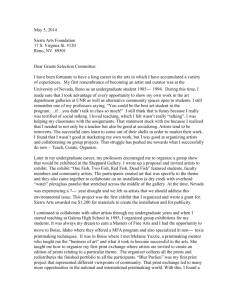Outcomes, legacies, implications
advertisement
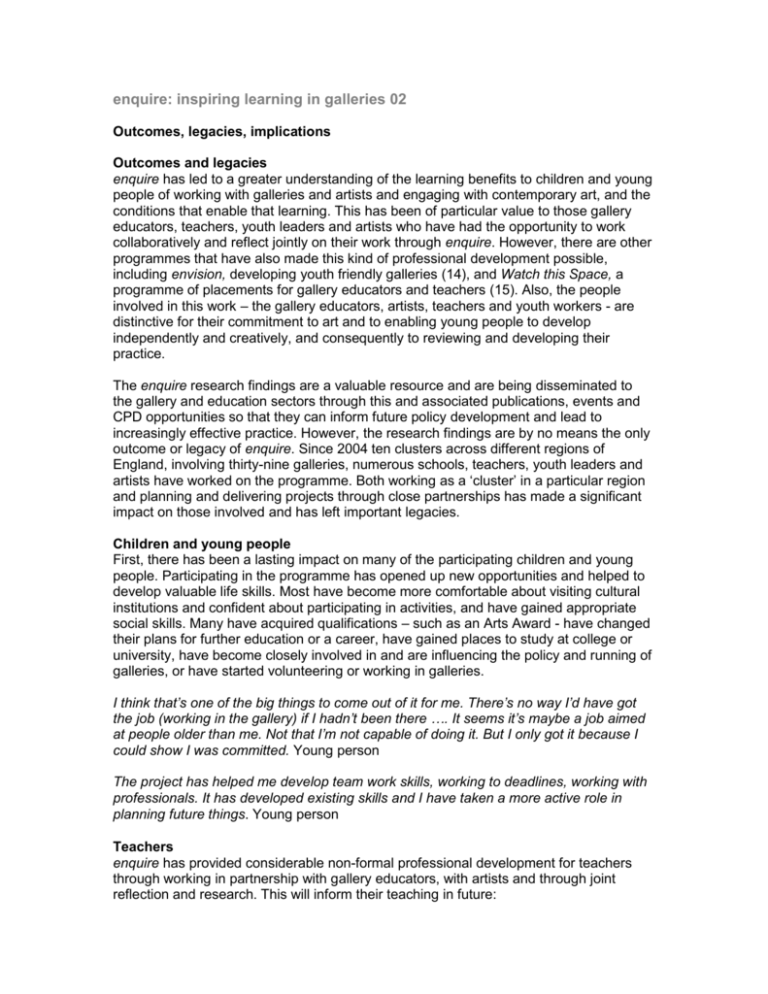
enquire: inspiring learning in galleries 02 Outcomes, legacies, implications Outcomes and legacies enquire has led to a greater understanding of the learning benefits to children and young people of working with galleries and artists and engaging with contemporary art, and the conditions that enable that learning. This has been of particular value to those gallery educators, teachers, youth leaders and artists who have had the opportunity to work collaboratively and reflect jointly on their work through enquire. However, there are other programmes that have also made this kind of professional development possible, including envision, developing youth friendly galleries (14), and Watch this Space, a programme of placements for gallery educators and teachers (15). Also, the people involved in this work – the gallery educators, artists, teachers and youth workers - are distinctive for their commitment to art and to enabling young people to develop independently and creatively, and consequently to reviewing and developing their practice. The enquire research findings are a valuable resource and are being disseminated to the gallery and education sectors through this and associated publications, events and CPD opportunities so that they can inform future policy development and lead to increasingly effective practice. However, the research findings are by no means the only outcome or legacy of enquire. Since 2004 ten clusters across different regions of England, involving thirty-nine galleries, numerous schools, teachers, youth leaders and artists have worked on the programme. Both working as a ‘cluster’ in a particular region and planning and delivering projects through close partnerships has made a significant impact on those involved and has left important legacies. Children and young people First, there has been a lasting impact on many of the participating children and young people. Participating in the programme has opened up new opportunities and helped to develop valuable life skills. Most have become more comfortable about visiting cultural institutions and confident about participating in activities, and have gained appropriate social skills. Many have acquired qualifications – such as an Arts Award - have changed their plans for further education or a career, have gained places to study at college or university, have become closely involved in and are influencing the policy and running of galleries, or have started volunteering or working in galleries. I think that’s one of the big things to come out of it for me. There’s no way I’d have got the job (working in the gallery) if I hadn’t been there …. It seems it’s maybe a job aimed at people older than me. Not that I’m not capable of doing it. But I only got it because I could show I was committed. Young person The project has helped me develop team work skills, working to deadlines, working with professionals. It has developed existing skills and I have taken a more active role in planning future things. Young person Teachers enquire has provided considerable non-formal professional development for teachers through working in partnership with gallery educators, with artists and through joint reflection and research. This will inform their teaching in future: I actually think just even the discussions, the relaxed discussion we have with the artist, and with other teachers, we’ve learnt a lot from each other, and certainly a lot from the artists, but apart from ideas, it sparks ideas off. Teacher Well my film is very – I'm hoping it’s very child orientated, I want to use it as a hook to make the children be interested in the project, and it’s based round football, ‘cause sport is a very popular subject in our school, the boys are very keen on football…...So that was my purpose, that’s my reason for doing it…I would have loved to have done something more personal, but that'll have to wait, because I want to learn the skills and take the skills back to school. Teacher The networks that have developed between teachers and schools, and with cultural institutions and artists, will also influence and support the teachers’ work in future. These networks can be particularly valuable in rural areas: You find out what's going on, because we are a bit out on a limb up here in Berwick aren’t we? So it is good to know what's going on, Newcastle, up here and all over I guess. Teacher Some teachers have also learnt new skills, particularly in digital media, as with this Middle School teacher taking part in a CPD project in Northumberland: I'm a feeder school to the High School, and I can give my children a taste of filmmaking, photography and hopefully some sound. And I'm certainly going to work across the curriculum with their teachers as well, in Year 8…I'm going to do English, we’re going to do play scripts and videoing… And certainly at our school, I mean ICT is very high on the agenda, and we’re supposed to cover it in all of the subjects, and it’s a way of broadening my vision of how it can be brought into art. And bits of it fed into what I do already, but long term to do some kind of stand alone film/video/whatever – project. Schools There have also been legacies among schools including Brixham College, where, as a result of working with the Lighthouse Visual Arts Centre, there is increased support amongst teachers and senior management for working with the gallery and with artists. The College has written into its self-development plan (SDP) that it wants at least thirty students to participate in local contemporary art gallery visits (to include a workshop with an artist educator) every year. The College is also programming more cross-curricular artist-led projects as a direct result of the success of the enquire project – and has allocated money to make this a reality. Artists The research reveals the particular role of artists, their status as independent people working in the ‘real’ world, how their pedagogies enable children and young people to develop their own ideas and opinions, and their skills complement those of teachers. Working partnerships between artists and teachers and more formal training has increased understanding about their respective roles and how they can work together to great effect. Artists have been introduced to galleries, museums and staff that they had not worked with before, extending their networks and possibilities for future projects. The programme has also provided considerable non-formal training for artists which they will use throughout their careers. Through formal and non-formal CPD artists have learnt: about schools and the curriculum from working with teachers and in schools about planning projects from working alongside gallery educators about research, educational theory and pedagogy And some of the artists have reported that working on the projects has helped to focus their own practice and also built on their experience of working with different age and ability groups of young people, helping them to make more informed decisions for the future: Yeah, so generally, in fact most of the time, you go into a class and say you're given eight to fifteen kids and you go off and work separately to the rest of the classroom. But actually, working with the teachers more closely, and thinking well actually, what they will get out of it and what I will get out of it and the kids will get out of it will be a better, more rounded experience. Artist Artists have also valued working with each other, particularly: finding out about each other’s practice and how it relates to the projects they develop, learning from each other’s delivery of the sessions (especially where artists working on the same project were working in different media), having other people to develop ideas with and being stretched. And enquire has enabled many artists to have a bigger ‘voice’ within the partnerships. Galleries and gallery educators Participating galleries and gallery educators have seen significant developments in their capacity to deliver increasingly effective work. Several gallery educators have moved to more responsible posts in larger organisations – partly as a result of taking part in enquire. They have not only furthered their own careers but have taken with them contacts and valuable experience that benefits their new situation. Similarly, new education staff taking up posts in participating galleries have been able to slot into the supportive network of a cluster and carry forward more ambitious partnerships and programmes. Galleries have developed new methods for evaluation as a result of taking part in collaborative research projects, including more creative and inclusive ways of eliciting views from young people. In institutional terms, as a result of the success of its enquire project, Quay Arts, which joined the South East cluster in Autumn 2007, is applying for funding to establish an education post. The Sainsbury Centre has seen important cultural change. The Director is very impressed by work undertaken with a group of self-directed young people through enquire, and by their keen involvement in the gallery. Consequently, there is now commitment to an annual ‘en-titled’ exhibition, to be curated by and showcasing work by young people. The learning from enquire has fed directly into the De La Warr Pavilion’s new programme of work, funded by the Paul Hamlyn Foundation, which includes a new model for planning and evaluation and an action learning set with gallery educators, artists and teachers. Regional partnerships and networks Both working as clusters and the projects themselves have led to strong and effective regional partnerships and networks that will enable further work between galleries and schools, and impact positively on the learning experiences of young people in future. Groups of galleries are joining together to promote their work to schools. In Devon, enquire has helped the galleries see their strengths and what they can offer jointly to schools and youth groups. This has led to the production of a regular e-bulletin and coordinated advocacy for all the venues and programmes across the South West, as well as working together on projects and workshops. Spacex, CCANW and Phoenix have started to produce joint marketing to schools, and are collaborating on a ‘contemporary art tour’, a three-art-venues-in-one-day bus tour for secondary schools being piloted in Summer 2008. In recognition of the value of the cluster model and the benefits of peer networking the South East cluster has been formally constituted as an unincorporated association to be known as the South East Gallery Educators Network. Galleries that joined the South East cluster in phase 2, on the Isle of Wight, in Portsmouth and Southampton, are forming a new cluster to work on enquire phase 3, with support from members of the original network. During 2007-8 ISIS worked with artists and teachers from schools in and around Berwick to develop skills in new media and carry out projects with their pupils. The teachers formed practical partnerships with other schools – including between feeder middle and upper schools – and with visual arts organisations. The local Arts Development Officer joined the steering group. Work made through the projects was exhibited at the Gymnasium Gallery in Berwick and the Berwick Film Festival has agreed to a screening specifically for the young people’s work as part of the mini film and media festival. One thing that I have found is that I've made contacts, I've learnt about equipment, even just asking where to buy that paper, and one of my colleagues is getting me a lead, and the chap from the Gymnasium Gallery came in - that's another name, another contact, so it’s really - networking has been very useful actually. Teacher These are examples of sound legacies that will support and enable the implementation of the policies outlined in the contextual section Art Education in England; the new secondary curriculum with its emphasis on personalisation, cross-curricular working and developing young people’s life skills and creativity; the Diploma in Creative and Media and the need for real projects and placements in creative organisations; and the Cultural Offer and its promise of five hours of culture each week for every young person in the country. Implications This report is being published at an exciting and challenging time, when enquire and other research is consistently evidencing the learning benefits of gallery education to children and young people, and the value of galleries and other cultural institutions in extending experience and the learning provided in schools is recognised by government. Both cultural and education policies are demanding: - that young people are given opportunities to experience culture of the highest quality that young people are encouraged and enabled to fulfil their potential, and ‘find their talent’ that schools develop a more flexible and personalised curriculum that makes use of alternative – including cultural - spaces and institutions that children be educated in ways that develop life skills such as team working and self-esteem that schools teach in ways that develop young people’s creativity – across the curriculum and that young people should gain real life experiences of working in the cultural sector, in preparation for working in the creative industries Whilst the new secondary curriculum recognises the importance of subjects, it places a strong emphasis on the development of skills for life and work, and builds in a framework for personal, learning and thinking skills. This framework is applied under six headings: - independent enquirers creative thinkers team workers self-managers, effective participation and reflective learners It is fascinating to see how closely the enquire research findings match the aims of the new secondary curriculum It is self-evident that the changes to the national curriculum, the introduction of new qualifications such as the Diploma in Creative and Media and Arts Awards, and the Learning Outside the Classroom manifesto will lead to a substantial increase in demand to access galleries and for support from gallery educators. This is a huge challenge to a sector that feels itself to be under-resourced. The Burns Owens statistics (2005) stand in stark contract to the expectations on the gallery sector. Although there are approximately 1,200 organisations in England programming the contemporary visual arts, many are very small: half of all organisations presenting contemporary visual arts in England have five employees or less (including part-time staff). Interdisciplinary activity is now relatively common across the sector and 60% of organisations have collaborated with other sectors, principally education. There is a strong commitment to education and outreach work. In the non-commercial sector 71% of organisations in England provide dedicated programmes of education and outreach. Children and young people (aged up to 24) is by far the most common target group. Despite this apparent commitment to education and outreach work, only a third of organisations in England actually have any dedicated education/outreach staff and only 4% of their budget is allocated to this work. The gallery sector is complex and there is no parity of provision. It is polarised between large-scale national and local authority run museums and galleries that are comparatively well resourced, and a plethora of small and medium scale voluntary organisations that are genuinely under-resourced and fragile. Yet it is many of these smaller galleries that have taken part in enquire and other programmes. They undertake innovative education and outreach work with artists and provide opportunities for schools and independent young people in parts of the country where there would otherwise be no access to exhibitions and contemporary art. These galleries are crucial to the delivery of the Cultural Offer and to the concepts of excellence and inclusion. The issue of capacity needs to be addressed by policy makers, by the gallery sector itself, by local education authorities and individual schools, and through professional development. Policy makers: - need to provide specific funding for galleries to develop the staff and resources to respond adequately to increased demand - need to recognise the importance of regional networks for peer support, CPD, raising the profile of galleries and advocacy - and the key role of gallery educators as brokers and mediators Gallery sector: - galleries should be spending a higher percentage of budgets on access and learning - outreach and education staff need to occupy management positions and exert greater influence in cultural organisations - similarly, organisations need to appoint Board members who are knowledgeable and committed to learning and access - if galleries are to be more open and responsive to young people there needs to be investment. This is not only about capacity, but also about having the skills to respond appropriately - galleries need to nurture young people – particularly from diverse backgrounds so that they provide genuine access and employment opportunities in the creative industries - and galleries need to become more articulate about what they have to offer Local education authorities and schools: - there needs to be greater awareness amongst teachers of the support and opportunities available through galleries - greater recognition of the education sector, of the role of galleries and artists in delivering the new initiatives and agendas and realistic budgeting for the costs involved - particularly among senior managers - a more sophisticated understanding of the particular role of the artist and adherence to professional fees that recognise experience and training - a better understanding in schools and amongst career advisors of the diverse career paths possible through studying art and design and an expansion of types of visual arts organisations that the schools work with, to include artist studios, public art projects Continuous professional development: - there needs to be a considerable improvement in the status, quality and professionalism of the gallery sector involving CPD, leadership training and experience, diversification and improved salaries - greater use of artists for education projects associated with museums - joint and practical CPD for teachers and artists, including placements, exchanges and mentoring - and placements for Initial Teacher Trainees in galleries as well as in schools The enquire research provides valuable evidence of precisely what children and young people learn through engaging with galleries, contemporary art and artists and the conditions that enable that learning. It also demonstrates how galleries and artists and sustained partnerships with schools and teachers can support the teaching of art and design and the aims of Every Child Matters, along with other education and cultural policies. The gallery sector has shown how – from large national to small local organisations can rise to the current challenges and make a significant difference to teaching, and to the skills and aspirations of young people.


